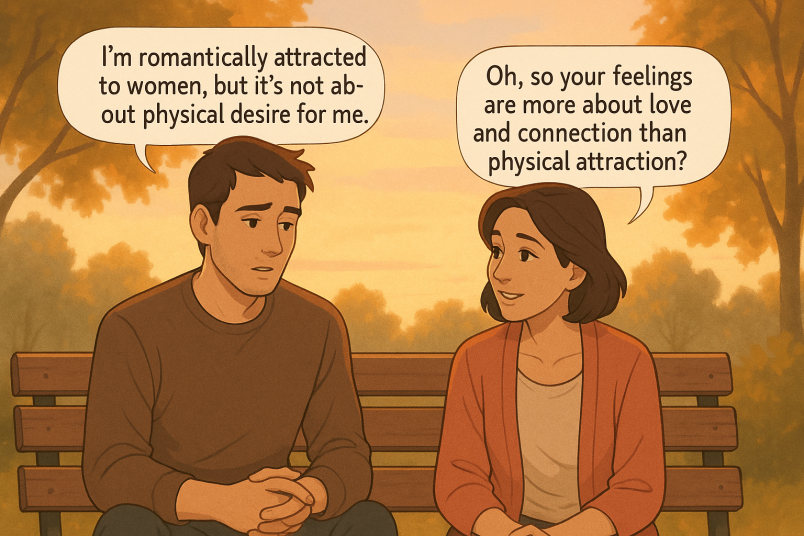7 Possible Signs You Have a Heteroromantic Orientation

Unlock Daily 30-Sec Tips for a Happier Relationship
👉 Subscribe FREEKey Takeaways
Marriage.com AI Quick Summary
Sometimes, feelings don’t follow the patterns we’re used to… You may find yourself drawn to someone’s warmth, kindness, or charm, and notice that your heart lights up around the opposite gender—even when physical attraction isn’t the center of it all.
Romantic longing can show up in subtle ways; a smile that lingers, a conversation you can’t stop replaying, or a sense of comfort that feels like “this is where I belong.” It’s a connection rooted in affection and emotional closeness, not desire.
That’s the beauty of a Heteroromantic experience—where love speaks louder than physical pull, and tenderness feels enough.
What does it mean to be heteroromantic?
Being heteroromantic means experiencing romantic attraction toward people of the opposite gender, without necessarily experiencing physical or sexual attraction. In other words, someone may deeply desire emotional closeness, dating, or love with the opposite sex, but not feel the same in terms of sexual attraction.
For example: A woman who identifies as bisexual might be sexually attracted to both men and women but only feel the urge to engage in romantic activities, such as dating or forming a romantic bond, with men. This illustrates her heteroromantic orientation.
Please note:
If this resonates with you, remember—it’s completely valid. Orientation is a spectrum, and identifying as heteroromantic doesn’t make your feelings any less real, meaningful, or deserving of respect.
How do romance and sexuality differ?
Romance and sexuality are two aspects of human relationships and personal identity that often intermingle but can also exist independently of each other.
Understanding this distinction is essential to appreciating the full spectrum of romantic orientation diversity, which acknowledges that people’s emotional and physical attractions do not always align.
Aspect Romance Sexuality
Definition Romance involves emotional and psychological attraction and connection. Sexuality refers to physical and sexual attraction to others.
Expression Romantic actions include dating, emotional intimacy, and affection. Sexual actions involve physical intimacy, such as kissing and sexual activities.
Orientation Examples include heteroromantic, homoromantic, and biromantic. Examples include heterosexual, homosexual, and bisexual.
Independence One can feel romantic attraction without sexual desire. One can have sexual desires without a romantic connection.
Relationships Often based on long-term emotional connections and bonds. Can be based on physical attraction regardless of emotional depth.
7 potential signs you have a heteroromantic orientation
Understanding your romantic orientation can greatly enhance your self-awareness and improve your relationships. If you find yourself predominantly attracted to individuals of the opposite gender in romantic ways, you might have a heteroromantic orientation.
Recognizing the signs of this orientation can help distinguish it from other romantic attraction types and provide clarity about your amorous preferences. Here’s a look at some probable signs that you might identify with a heteroromantic meaning.
1. You primarily develop crushes on the opposite gender
If you notice that your romantic feelings are almost always for people of the opposite gender, this is a strong indicator of a heteroromantic orientation. These feelings are more about emotional and romantic connections rather than just physical or sexual attraction.
A study highlights the crucial role of Emotional Intelligence (EI) in enhancing the quality of romantic relationships. It asserts that relationships characterized by high EI among partners tend to be more committed and stable.
You might fantasize about going on dates, sharing intimate moments, or building a life together with individuals of the opposite sex.
- For example: You might find yourself daydreaming about holding hands with a classmate of the opposite gender or imagining what it would be like to be their partner.
2. You desire romantic relationships with the opposite gender
Those with a heteroromantic orientation often envision their future and long-term romantic relationships, specifically with partners of the opposite gender. This isn’t about societal expectations but a genuine desire to connect emotionally and romantically with these individuals.
Your daydreams about romance typically involve someone of the opposite sex, which sets apart your romantic orientation from non-heterosexual relationships.
- Example: You might imagine introducing a future boyfriend or girlfriend (of the opposite gender) to your family or daydream about planning a wedding with them someday.
3. Lack of romantic interest in the same gender
A telling sign of having a heteroromantic orientation is the absence of romantic interest in the same gender.
While you might appreciate them as friends or find them aesthetically attractive, there is no desire to pursue anything beyond a platonic relationship. This distinction is crucial in understanding the aromantic spectrum and other romantic attraction types that do not conform to heteroromantic norms.
- Example: You may admire a same-gender friend’s style or personality, but when you picture romance, it’s always someone of the opposite gender who comes to mind.
4. Romantic gestures feel natural only toward the opposite gender
If you find that romantic gestures such as flirting, buying gifts, or writing love letters come naturally only when directed toward the opposite gender, this could reflect your heteroromantic orientation.
According to Danica Mitchell, a sex therapist:
This is not to say you can’t feel awkward if you are new to flirting or making romantic gestures; being romantic can be anxiety-producing.
A survey of 295 college students revealed that different types of romantic physical affection (PA)—excluding sexual intimacy—are strongly linked to relationship satisfaction. The study evaluated seven PA types, finding significant correlations between most PAs and higher relationship satisfaction and ease of conflict resolution, particularly with cuddling, kissing, and hugging.
Such an inclination shows where your romantic energies are most comfortably and instinctively directed, differing from queerplatonic partnerships, which might not involve these traditional expressions of romance.
- Example: Writing a heartfelt love note or picking out a small gift feels exciting when it’s for a crush of the opposite gender, but awkward or out of place for same-gender friends.
5. Your romantic fantasies involve the opposite gender
For someone with a heteroromantic orientation, romantic fantasies typically involve people of the opposite gender. These fantasies can be about scenarios like marriages, romantic holidays, or simply sharing domestic life. They are not just whims; they are reflections of your deep-seated romantic inclinations and preferences.
- Example: You might daydream about going on a beach holiday with an opposite-gender partner, or imagine cuddling on the couch together after a long day.
6. Emotional intimacy with the opposite gender feels more fulfilling
You might find that emotional intimacy with the opposite gender is more fulfilling and satisfying, indicating a heteroromantic orientation.
Research indicates that emotional intimacy makes a major contribution to relationship quality. It helps to buffer daily stress and thus enhances the well-being and adjustment of partners. Emotional intimacy also significantly boosts the satisfaction of partners with their sexual relationship.
It doesn’t mean you don’t value friendships with others, but that the emotional depth and connection you seek in a romantic context are found specifically with the opposite gender. This is a key aspect of your romantic orientation, differentiating it from other types.
- Example: Sharing secrets late at night or opening up about your fears feels deeper and more meaningful when it’s with someone of the opposite gender, compared to conversations with same-gender friends.
Watch this TED Talk by Terri Orbuch, relationship expert, who shares ways to tell if it’s lust or love—and how to rekindle passion.
7. Consistent pattern of opposite-gender relationships
A consistent pattern of forming romantic relationships with the opposite gender can signify a heteroromantic orientation. This pattern shows a clear preference and comfort in amorous relationships with the opposite sex, distinct from exploring various types of non-heterosexual relationships or queerplatonic partnerships.
- Example: Looking back, every crush, first date, or serious relationship you’ve had has been with someone of the opposite gender, showing a steady romantic pattern.
FAQs
To help clarify some common queries about heteroromantic orientations, which describe individuals who experience romantic attraction toward the opposite gender, below are answers addressing variations within the orientation and exploring its nature and flexibility.
-
What are the different types of heteroromantics?
Heteroromantic individuals can vary widely in their other personal traits and preferences. Some might be asexual, experiencing no sexual attraction to others, while others might have sexual attractions that align or differ from their romantic attractions.
-
What is the heteroromantic asexual meaning?
A heteroromantic asexual person feels romantic attraction toward individuals of the opposite gender but does not experience sexual attraction to any gender. They seek romantic relationships without the aspect of sexual intimacy.
-
Can you stop being heteroromantic?
Romantic orientation, like sexual orientation, is typically a deep-seated aspect of one’s identity. While people’s understanding of their own preferences might evolve, it’s not usually something one can consciously change or choose to stop being.
Wrapping up
Understanding your romantic orientation is a journey of self-discovery, not a test you have to pass. If you resonate with the signs of being heteroromantic, know that your feelings are valid and real—love expressed through emotional closeness, affection, and companionship is just as meaningful as any other kind.
Danica Mitchell highlights that:
Being heteroromantic is the societal default, but it is still important that you take time to assess if that is what actually feels right for you.
Whether you’re reflecting on past relationships or imagining your future, what matters most is honoring how your heart connects with others. Embrace your orientation with kindness to yourself, because every way of experiencing love deserves respect and recognition.
 Tips
Tips
Write your tip or submit a video tip
All tips are reviewed before the publishing.
Share this article on
Want to have a happier, healthier marriage?
If you feel disconnected or frustrated about the state of your marriage but want to avoid separation and/or divorce, the marriage.com course meant for married couples is an excellent resource to help you overcome the most challenging aspects of being married.
Recent Articles
Related Quizzes
Unlock Daily 30-Sec Tips for a Happier, Healthier Relationship
👉 Subscribe FREE on YouTube We'd love your feedback!
We'd love your feedback!
 Expert Q&A
Expert Q&A
Ask your question related to this topic & get the support you deserve from experts.




















 Thanks for your feedback!
Thanks for your feedback!